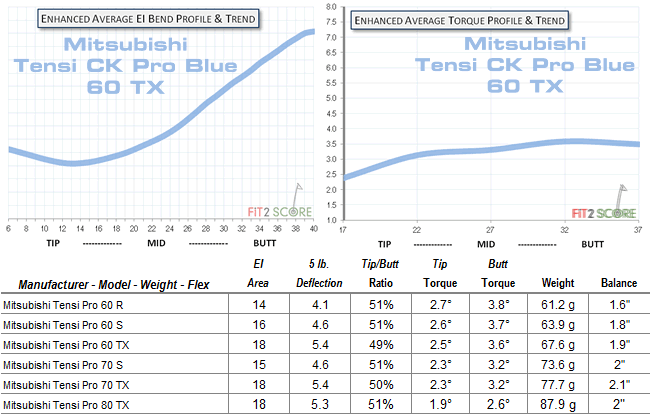Mitsubishi Tensi CK Pro Blue Driver Shafts
By Russ Ryden, A Golf Digest America’s 100 Best Clubfitter
Fit2Score, Dallas Fort Worth, Texas
It is no longer appropriate to use the word graphite to describe a golf shaft material. In fact, the term carbon fiber does not work either. Many of today’s golf shafts must be referred to a composites. They are blends of carbon fiber strands, carbon fiber weaves, metal wire, metal mesh, metal powder, kevlar, boron and resin. These exotic combinations are increasing strength at reduced weight. This creates a wider range of properties that can be created in the composite tapered tube we call a golf shaft. The Mitsubishi Tensi is a new blend of materials woven into a driver shaft.
Mitsubishi is vertically integrated. they make most all of the materials the go into a golf shaft including monomer, acrylic fiber, carbon fiber, resin and prepreg. Mitsubishi’s latest PR releases tell us what that means: 276 PGA Tour wins on the major tours since 2004, 80 more than the next closest competitor. $137 million in prize money in 2015, $40 million more than the closest competitor. If that does not get your attention, the feel of their shafts will. They use the name Thump on a few products. It is fitting. The high density material they use dampens vibration up the shaft. What gets to your hands is a thump, not a click. When you strike your driver center face, that thump is an exquisite feeling. You can sense the ball getting crushed.
The 2016 Tensi CK Pro Blue is a multi-material design combining 11 different prepreg materials. The profile is very much like a Diamana B. As shown below, the difference between the 60, 70 and 80 gram versions of the TX profile is weight and torque. The stiffness and bend profiles are identical. This is different from Mitsubishi models in the past. Typically the weight and stiffness must be considered together, the heavier shafts are stiffer with the same flex designation.
The shafts covered in this review are the Boron tipped Pro version. They are not to be confused with the shafts that will be offered in OEM off the rack drivers. Those lack the boron tips and are available in a wider range of weights and flex. The Boron tip weave adds tip stiffness to the Diamana B profile.
A carbon fiber / Kevlar weave is used in the butt section of the shaft. It can be seen through the clear finish. While the bend profile of the shaft is just slightly stiffer than the classic blue design, the hoop strength in this area is significantly increased. That should result in a little tighter dispersion for an aggressive swing.

As you can see in the chart, these are high balance point shafts, but not as high as the third generation Diamana B. We are seeing driver head weights come do a few grams and the shaft designers have moved the balance points accordingly. Radial consistency of the Tensi Pro averaged 99.3% with a 0.4% standard deviation. Great numbers for a shaft not made in Japan as are the other premium Mitsubishi shafts.
The Mistubishi Tensi was designed as Diamana B with new materials. What came to be from the new materials is a tighter tip and butt on a classic profile. Feedback from our testers is very positive. So positive in fact that one ordered a spare should something ever happen to his gamer.
